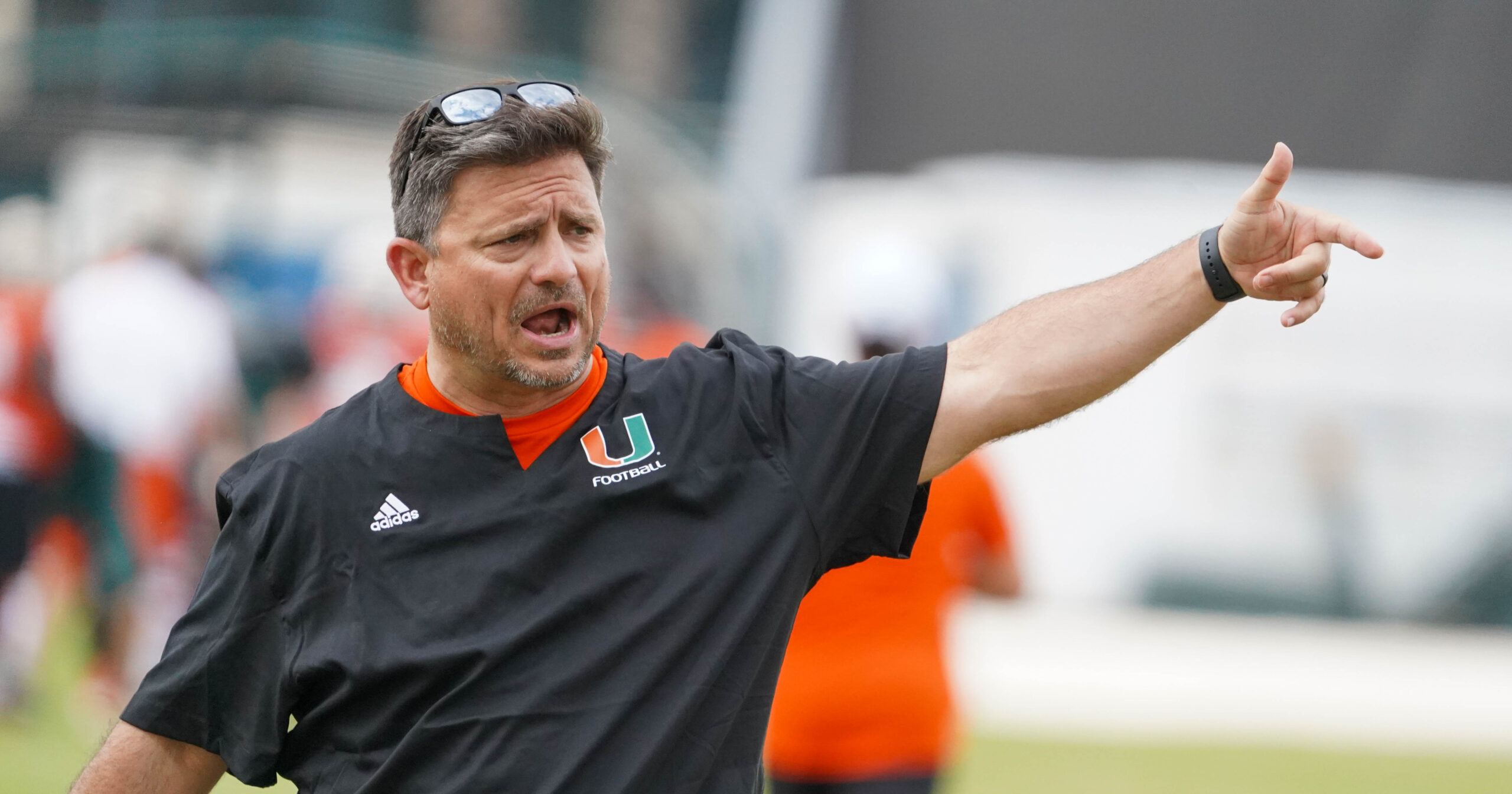ANALYSIS: Realistic expectations for this year’s Miami Hurricanes offense

There are plenty of reasons why the Miami Hurricanes finished 5-7 last season, and one of those was certainly a new offense headed by Josh Gattis that averaged just 23.6 points and 367.1 yards. That was significantly down from Rhett Lashlee’s attack the prior season that averaged a healthy 34.1 points and 448.8 yards.
A look under the hood shows that in 2022 Miami ranked No. 96 in the nation in scoring offense, No. 95 in rushing offense and No. 85 in total offense.
Yikes.
So now it’s on to the Hurricanes’ fourth coordinator in the last five years, Shannon Dawson. He follows on the heels of Gattis (one year), Lashlee (two years) and Dan Enos (one year). The hope is that Dawson won’t just provide some explosiveness off last year’s stagnant offense, but also some stability. It’s not easy for players or a program to have an entirely new offense installed every year or so, as has been the case at UM the last five years.
So what are the realistic expectations for this new hybrid Air-Raid attack that started getting installed by Dawson this spring?
Well, at Houston this past season, Dawson’s offense was No. 25 in the nation in total yards (455.8) and No. 8 in passing offense (314.0 yards) along with tied for 16th in scoring offense (36.1 points). His offense threw the ball 55 percent of the time, so it’s not a traditional pass-happy Air Raid. He likes a balanced offense with explosive elements from the run game, slot and outside receivers.
There is a lot to like about his attack and how it fits Miami’s athletes, and we saw some of the playmaking ability of his getting guys in space this spring.
With that said, though, unlike at Houston and the American Athletic Conference, ACC defenses are more complex and have better athletes than what Dawson faced at Houston.
So let’s take a look at the defenses he faced last year and where they ranked, and conversely the defenses that Miami will go up against this year and how they fared the last time they were on the field for games.
In 2022 there were 11 teams that Dawson’s attack gashed for 30 or more points. Here is their national defensive ranks last year in total yards allowed/points yielded:
UTSA (scored 37 points): Ranked No. 73 in nation in total defense (387.2 yards allowed); No. 58 in scoring defense (25.9 PPG)
Texas Tech (scored 30 points): No. 107 in total defense (425.5 yards); No. 92 in scoring defense (29.2 PPG)
Kansas (scored 30 points): No. 126 in total defense (469.4 yards); No. 123 in scoring defense (35.5 PPG)
Rice (scored 34 points): No. 75 in total defense (390.8 yards); No. 120 in scoring defense (34.2 PPG)
Memphis (scored 33 points): No. 50 in total defense (363.4 yards); No. 59 in scoring defense (26.0 PPG)
Navy (scored 38 points): No. 31 in total defense (339.0 yards); No. 51 in scoring defense (24.3 PPG)
USF (scored 42 points): No. 130 in total defense (516.6 yards); No. 129 in scoring defense (41.2 PPG)
SMU (scored 63 points): No. 111 in total defense (431.2 yards); No. 118 in scoring defense (33.8 PPG)
Temple (scored 43 points): No. 76 in total defense (391.2 yards); No. 94 in scoring defense (29.2 PPG)
East Carolina (scored 42 points): No. 87 in total defense (404.3 yards); No. 72 in scoring defense (27.2 PPG)
Tulsa (scored 30 points): No. 98 in total defense (414.2 yards); No. 116 in scoring defense (33.1 PPG).
The bottom line statistics, through the above lens: Of the teams that Dawson scored 30 or more points against last year, none ranked in the nation’s top 50 in scoring defense. And seven of the 11 opponents last year ranked worse than No. 90 in the nation in scoring defense with five of them ranking No. 116 or worse (and that’s out of 130 total teams in the nation). With that said, though, Dawson’s offense scored more than the average points against in seven of the 11 games.
The two defenses his team didn’t score 30 or more points against? That was against Tulane (24 points in OT) and Louisiana (23 points). Perhaps unsurprisingly those were also the defenses that ranked highest of Houston’s opponents, with Tulane ranking No. 46 in yards allowed (360.4) and No. 32 in scoring defense (22.2 points) while Louisiana was No. 49 in total defense (361.7 yards) and No. 36 in scoring defense (22.8 PPG).
So is there a bit of a caveat there in terms of Houston not facing top defenses? Sure. But it doesn’t mean Dawson and this Miami offense can’t come alive this year in a system that better fits the athletes on this team.
Now let’s look at the Canes’ side for a minute.
Here are this upcoming year’s Miami opponents and where those defenses ranked a year ago in total yards allowed and points per game allowed… while for the most part going against stronger competition than Houston did, of course:
Miami (Ohio): No. 60 in total defense (373.2 yards); No. 34 in scoring defense (22.6 PPG)
Texas A&M: No. 51 total defense (365.0 yards); No. 22 in scoring defense (20.7 PPG)
Bethune-Cookman: No. 82 total defense (408.5 yards); No. 117 in scoring defense (39.5 PPG)
Temple: No. 76 total defense (391.2 yards); No. 94 in scoring defense (29.2 PPG)
Georgia Tech: No. 84 total defense (401.0 yards); No. 83 in scoring defense (28.4 PPG)
North Carolina: No. 115 total defense (436.5 yards); No. 101 in scoring defense (30.8 PPG)
Clemson: No. 27 total defense (334.4 yards); No. 23 in scoring defense (20.9 PPG)
Virginia: No. 43 total defense (357.6 yards); No. 48 in scoring defense (24.0 PPG)
NC State: No. 19 total defense (326.9 yards); No. 11 in scoring defense (19.2 PPG)
Florida State: No. 14 total defense (321.8 yards); No. 20 in scoring defense (20.6 PPG)
Louisville: No. 23 total defense (330.2 yards); No. 11 in scoring defense (19.2 PPG)
Boston College: No. 66 total defense (377.8 yards); No. 99 in scoring defense (30.3 PPG)
The upshot?
Based on last year, Miami and Dawson will face four opponents that ranked in the nation’s top 25 in scoring defense last year, and only two ranked outside of the nation’s top 100 (Bethune-Cookman and UNC).
So Miami fans will get a great idea this year of just how effective Dawson’s attack can be at this level. Is it fair to expect a jump for Miami into the nation’s top 25 in scoring offense or total yards? Probably not.
But it is fair to expect quite a bit of improvement with a system a heck of a lot more like Lashlee’s than Gattis’.
There also is an influx of new talent (freshman RB Mark Fletcher, freshman WR Ray Ray Joseph, freshman WR Robby Washington, freshmen 5-star OL Francis Mauigoa and Samson Okunlola, and OL transfers Javion Cohen from Alabama and Matt Lee from UCF) that can help on this side of the ball with only minimal losses (TE Will Mallory is the main departure) … plus there is a healthy QB Tyler Van Dyke.
Add it all up and that should mean good news for Miami’s offense in 2023.
The post ANALYSIS: Realistic expectations for this year’s Miami Hurricanes offense appeared first on On3.
